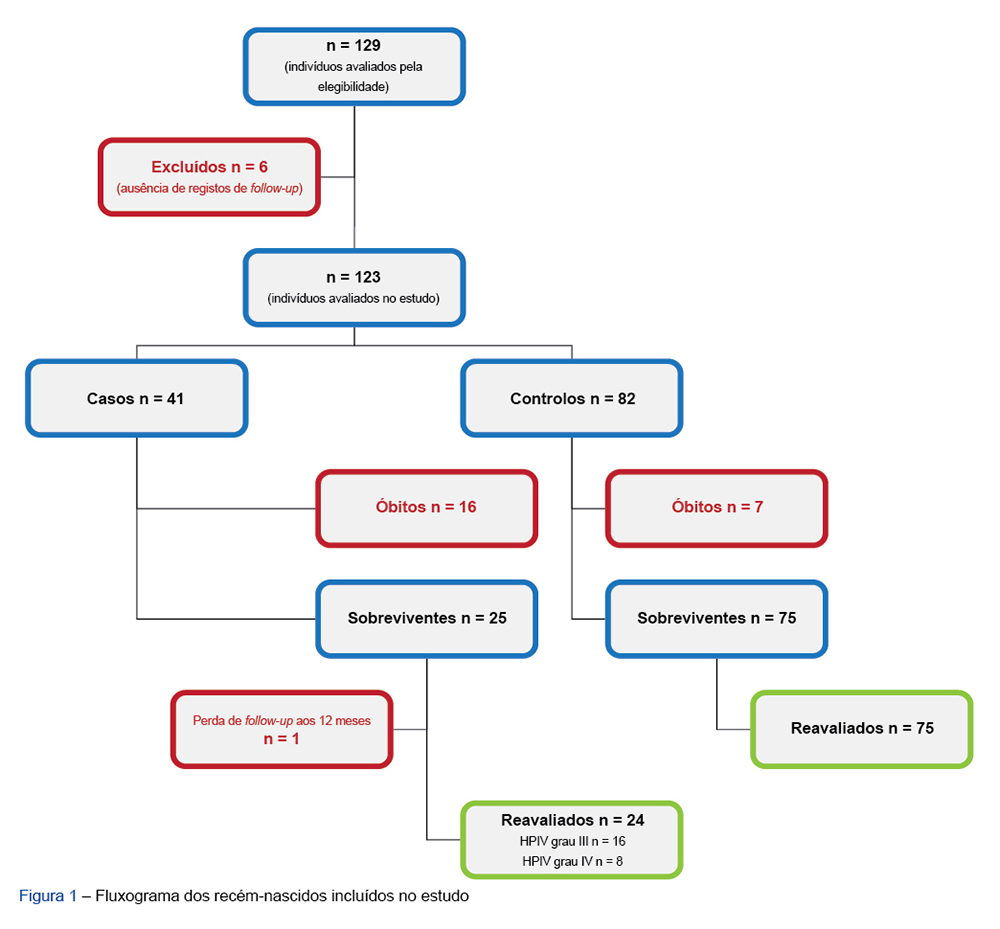SOCIAL MEDIA
Portuguese Medical Association's Scientific Journal

Introduction: Severe peri-intraventricular haemorrhage has been associated with higher mortality and neurodevelopmental impairment. The impact of peri-intraventricular haemorrhage alone (without white matter injury) remains controversial. The aim of this study was to evaluate the influence of severe peri-intraventricular haemorrhage, associated or not with cystic peri-ventricular leukomalacia, on mortality and neurodevelopment at 24 months.
Material and Methods: Retrospective cohort study, that included newborns with severe peri-intraventricular haemorrhage admitted to a maternity hospital with differentiated perinatal support between 2006 and 2015, and two controls with the same gestational age, without peri-intraventricular haemorrhage, who were admitted immediately after the case. Neurodevelopmental assessment, at 24 months, was performed in 99 children, using the Schedule of Growing Skills II scale in 52 and the Ruth Griffiths mental development scale in 47 children. Severe neurodevelopmental deficit was diagnosed in the following conditions: cerebral palsy, delayed psychomotor development, deafness requiring hearing aids and blindness.
Results: The study included 41 cases and 82 controls. Out of these, 23 died, 16 (39.0%) in the group of severe peri-intraventricular haemorrhage and seven (8.5%) in the control group (OR 7.6, 95% CI 2.6 - 20.4, p < 0.001). Severe neurodevelopmental deficit was diagnosed in seven (30.4%) in the severe peri-intraventricular haemorrhage group and one (1.3%) in the control group (OR 32; 95% CI 3.7 - 281, p < 0.001). Individualized analysis showed that mortality was higher in peri-intraventricular haemorrhage grade III with associated cystic peri-ventricular leukomalacia (OR 4.4 95% CI 1.3 - 14.2, p = 0.015) and in peri-intraventricular haemorrhage IV (OR 12; 95% CI 3.5 - 41.2, p < 0.001), when compared to controls. Differences were also noticed regarding severe neurodevelopmental deficit when compared with controls (1.3%) in grade III peri-intraventricular haemorrhage with associated cystic peri-ventricular leukomalacia, (75.0%, p < 0.001) and grade IV peri-intraventricular haemorrhage (50.0%, p < 0.001 ).
Discussion: This work showed a higher mortality rate and neurodevelopment impairment in preterm newborns with severe peri-ventricular haemorrhage. Analysis by groups stratified according to gestational age and different grades of peri-ventricular haemorrhage displayed the complications associated with peri-ventricular haemorrhage grade IV or grade III, with or without cystic peri-ventricular leukomalacia.
Conclusion: Preterm newborns with peri-intraventricular haemorrhage grade IV or grade III with cystic peri-ventricular leukomalacia, had a higher risk of mortality and severe neurodevelopmental impairment.